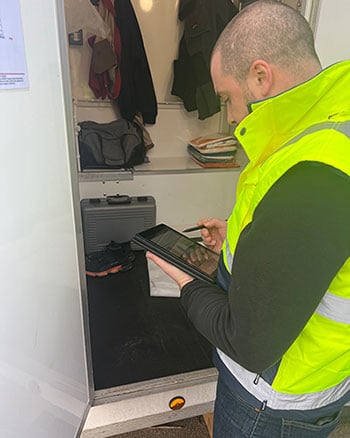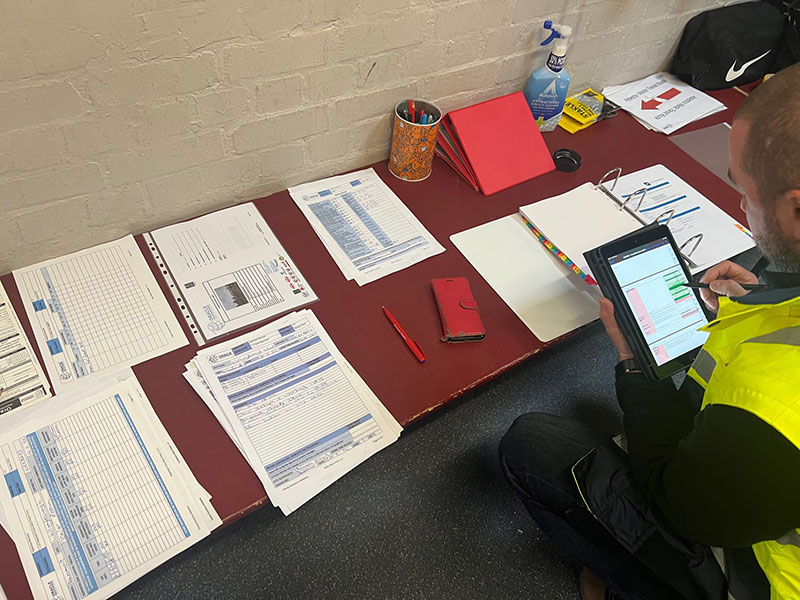What Paperwork & Documents Do You Need Once You Are Asbestos Trained?
You have had your asbestos non-licensed training. You have your insurance in place, and you have all the materials and equipment you need. You have your medical surveillance in place and have had face fit testing for the RPE you are using. You have made sure that you have a system in place for reviewing your performance to gauge competency and you are ready to start working on non-licensed asbestos. Now it’s time for the paperwork and documentation that you need.
For more information on equipment, materials and other elements required for undertaking non-licensed asbestos work look at this article.
 For many when it comes to the correct and suitable documentation it presents big challenges. The reason is that most do not understand the full requirements under current guidance and regulations when it comes to suitable and sufficient documentation. All too often this part of the process is left as an afterthought and this has disastrous consequences.
For many when it comes to the correct and suitable documentation it presents big challenges. The reason is that most do not understand the full requirements under current guidance and regulations when it comes to suitable and sufficient documentation. All too often this part of the process is left as an afterthought and this has disastrous consequences.
If your documentation is not adequate you are not compliant with the law and are at risk of potential prosecution if things go wrong. I want to take this opportunity to walk you through the basics so that you can have a clear understanding of the minimum requirements for compliance with the asbestos regulations. This forms part of the asbestos training you would have had, however its one of those things that after the training has finished tends to get forgotten.
The basic documentation
The list of documents that you can have to support your work with asbestos can be endless. For ease I have included in this list the absolute basics which you need to make sure you have in place. The sections after this will give you some brief details on each element to help with understanding the requirements.
The basic documents:
- Plan of Works (Method Statement)
- Standard Operating Procedures
- Asbestos Policy
- Operative Personnel File & Company Documents
Each one of these documents has sub sections which are detailed below. It is worthy of note that the detail in each of these documents will vary dependent upon the size of the work force undertaking asbestos work and the type or work being undertaken. This guide is an overview to give you a good starting point.
Plan of Works (Method Statement)
The Plan of Works (POW) or Method Statement is arguably one of the most important documents that you will need to produce. The POW is the document which you or your team must have on site whilst undertaking any asbestos work. The POW details what the work is and how it is going to be undertaken. It will detail the associated risks and it will detail the control measures which you are going to use to minimise or control those risks. This is all part of the risk assessment. The law states that you must assess the risk and reduce that risk as far as is reasonably practicable.
Your POW must contain the following information for those undertaking the work:
- Details of the site and specific location where the work is to be carried out
- The type of work and how it will be carried out
- The type of asbestos which must be confirmed via sampling or survey information
- A suitable assessment of the risk from asbestos
- A suitable assessment of non-asbestos risks
- All control measures employed to control any risks
- Recommended: Suitable plans of the work area
- Recommended: Suitable photographs of the work area and asbestos
The POW should also contain relevant information regarding all other H&S & additional elements such as welfare, power, water, access etc. In short, the POW must contain everything that those undertaking the work need to know to complete the work safely and efficiently.
The POW should also be accompanied by the relevant HSE notification form / documentation if you are undertaking Notifiable Non-Licensed Work (NNLW) on asbestos.
If the POW is a document that you are having challenges producing, then speak to a member of the Oracle team and they will be able to help you put this document together.
Standard Operating Procedures
Your Standard Operating Procedures (SOP’s) are a fundamental document which sets out how you work with asbestos and details every aspect of compliance in accordance with relevant regulations and guidance. If you do not have a set of SOP’s then your POW’s document will be far to large.
The idea behind the SOP’s is to have the general information which is the same on every project or job in one big document which can be referred to from the POW’s. For example, if you were removing asbestos cement sheeting as part of your work then your POW would only need to refer to the specific section within your SOP’s. You would have a very detailed section in the SOP’s which your site team can refer to on every project where you were doing this type of work. This keeps the POW document smaller and more user friendly on site.
Your SOP’s are the detail behind everything you do. This document should detail absolutely every element which is required to be in place for carrying out work on asbestos. It is your fully detailed instruction manual. The following are the main things which you should have in your SOP’s (This list is not exhaustive):
- How you ensure training and competency
- How you undertake medical surveillance
- How you monitor workers potential asbestos exposure
- How you undertake specific work on asbestos (detailed by work type)
- How you assess risk (asbestos and non-asbestos) including detailed assessments
- How you deal with asbestos waste
- How you maintain equipment including RPE & PPE
- What RPE & PPE you utilise and when
- How you notify relevant projects to the HSE
- How you put together site-specific POW’s
- How you keep SOP’s up to date and how you make that information available
- Emergency Procedures
- Decontamination Procedures
This is a basic list which will differ dependant upon you and what work you are undertaking. If you do not have SOP documentation and are unsure then speak to a member of the Oracle team and they can help you put this document together.
Asbestos Policy
Your asbestos policy is an important document which outlines your overall policy when it comes to asbestos. The policy should state what you will and will not do and how you intend to protect people form the risks of asbestos. The asbestos policy is usually contained within the Standard Operating Procedures. The asbestos policy is a legally required document for any company where they are likely to or potentially must consider asbestos risk.
Operative Personnel File & Company Documents
The Personnel File is the documents which every worker who is undertaking work on asbestos should have to hand. For non-licensed asbestos work the file is very basic. However the file can contain non asbestos information where required. Its good practice and reccomended that each and every worker has with them the following information which should be detailed within their personnel file and available for inspection if required:
- Asbestos Training Certificate
- Asbestos Medical Certificate
- Face Fit Test Certificate
- Recommended: RPE Maintenance / Inspection Records
- Recommended: Additional non asbestos information such as additional training etc.
Additionally in the Personnel File it is good practice to have the following company documents:
- Insurance Certification for Asbestos Work
- Waste Carriers License (If appropriate)
Conclusion
For those considering having or for those who have just had non-licensed asbestos training there is a lot more to undertaking asbestos non-licensed work safely and in accordance with asbestos regulations than just the training itself.
These things sometimes get overlooked and can create big challenges. We have a full range of packages to help you put together everything you need for full compliance. Speak to a member of the team now for full information and find out how we can help.

Written by Jess Scott
Jess Scott has been an all-round asbestos consultant since 1996. That’s nearly 3 decades of asbestos knowledge. He spends his time sharing that knowledge with the team at Oracle and with their clients. Jess's goal is, and always has been, to use my expertise in helping people to comply with the law. This legal compliance ultimately helps to protect everyone from the harmful effects of asbestos. Jess has acted as an asbestos expert witness in legal cases and is involved in many asbestos educational activities throughout the UK.

